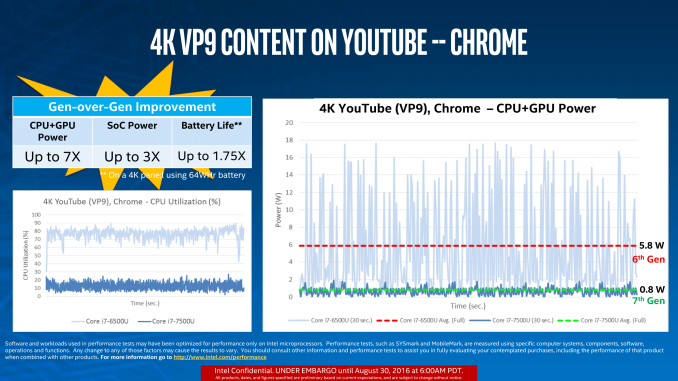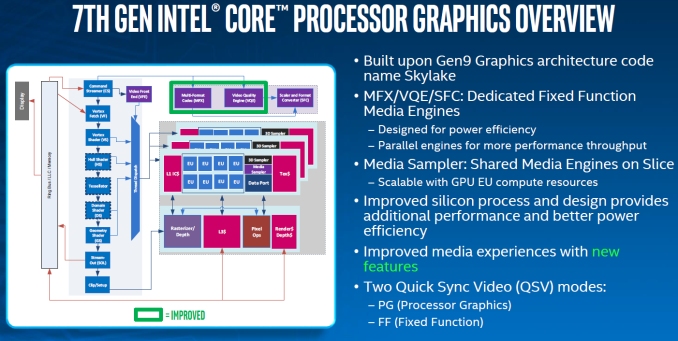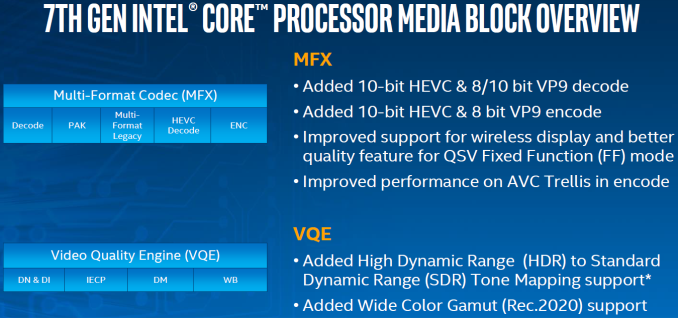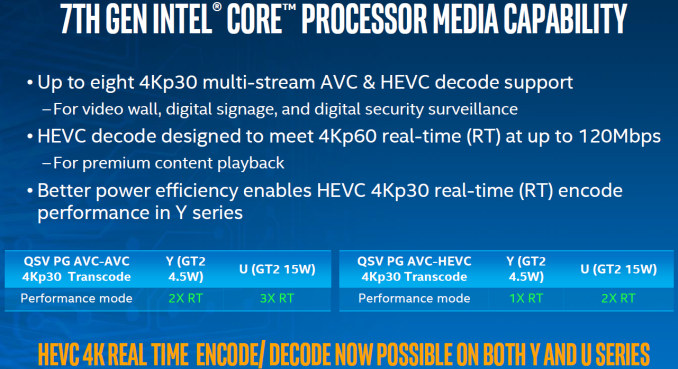Intel Announces 7th Gen Kaby Lake: 14nm PLUS, Six Notebook SKUs, Desktop coming in January
by Ganesh T S & Ian Cutress on August 30, 2016 9:00 AM EST- Posted in
- CPUs
- Intel
- 14nm
- Kaby Lake
- Gen 9
- Speed Shift
- Turbo Boost
The Kaby Lake-U/Y GPU - Media Capabilities
While from a feature standpoint Kaby Lake is not a massive shift from Skylake, when it comes to GPU matters it none the less brings across some improvements that are directly visible to the end-user. As with the CPU cores, Intel’s 14nm+ process will allow for higher GPU frequencies and overall better GPU performance, but arguably the more impressive change with Kaby Lake is the updated media capabilities. To be clear, Kaby Lake is still an Intel Gen9 GPU – the core GPU architecture has not changed – but Intel has revised the video processing blocks to add further functionality and improve their performance for Kaby Lake.
The media capabilities of the Skylake GPU was analyzed in great detail in our 2015 IDF coverage. The updates to Kaby Lake-U/Y should be analyzed while keeping those features in mind. The major feature change in the Kaby Lake-U/Y media engine is the availability of full hardware acceleration for encode and decode of 4K HEVC Main10 profile videos. This is in contrast to Skylake, which can support HEVC Main10 decode up to 4Kp30, but does so using a “hybrid” process that spreads out the workload over the CPU, the GPU’s media processors, and the GPU’s shader cores. As a result, not only can Kaby Lake process more HEVC profiles in fixed function hardware than before, but it can do so at a fraction of the power and with much better throughput.
Also along these lines, Kaby Lake has implemented full fixed function 8-bit encode and 8/10-bit decode support for Google’s VP9 codec. Skylake offered hybrid decode support for the codec, which is useful from a feature standpoint, but is a bit more problematic in real-world use since it’s not as power-efficient to use VP9 a codec implemented in fixed function hardware. Google has proven eager to serve up VP9 to its YouTube users, so they can now much more efficiently decode the codec. Meanwhile, on the encode side, brand-new to Kaby Lake is VP9 encoding support, to go with the aforementioned HEVC encode support.
| Intel Video Codec Support | |||||
| Kaby Lake | Skylake | Broadwell | |||
| H.264 Decode | Hardware | Hardware | Hardware | ||
| HEVC Main Decode | Hardware | Hardware | Hybrid | ||
| HEVC Main10 Decode | Hardware | Hybrid | No | ||
| VP9 8-Bit Decode | Hardware | Hybrid | Hybrid | ||
| VP9 10-Bit Decode | Hardware | No | No | ||
| H.264 Encode | FF & PG-Mode | FF & PG-Mode | PG-Mode | ||
| HEVC Main Encode | FF & PG-Mode | PG-Mode | No | ||
| HEVC Main10 Encode | FF & PG-Mode | No | No | ||
| VP9 8-Bit Encode | FF & PG-Mode | No | No | ||
| VP9 10-Bit Encode | No | No | No | ||
An overview of the GPU engine in Kaby Lake-U/Y is presented in the slide below.
The new circuitry for hardware accelerating HEVC Main10 and VP9 are part of the MFX block. The MFX block can now handle 8b/10b HEVC and VP9 decode and 10b HEVC / 8b VP9 encode. The QuickSync block also gets a few updates to improve quality further, and AVC encode performance also receives a boost.
The Video Quality Engine also receives some tweaks for HDR and Wide Color Gamut (Rec.2020) support. Skylake's VQE brought in RAW image processing support with a 16-bit image pipeline for selected filters. While Intel has not discussed the exact updates that enable Rec.2020 support, we suspect that more components in the VQE can now handle higher bit-widths. Intel pointed out that the HDR capabilities involve usage of both the VQE and the EUs in the GPU. So, there is still scope for further hardware acceleration and lower power consumption in this particular use-case.
Intel claims that Kaby Lake-U/Y can handle up to eight 4Kp30 AVC and HEVC decodes simultaneously. HEVC decode support is rated at 4Kp60 up to 120 Mbps (especially helpful for premium content playback and Ultra HD Blu-ray). With Kaby Lake-U/Y's process improvements, even the 4.5W TDP Y-series processors can handle real-time HEVC 4Kp30 encode.
On the subject of premium content, in their presentation Intel rather explicitly mentioned that the improved decode capabilities were, in part, for “premium content playback.” When we pushed Intel a bit on the matter – and specifically on 4K Netflix support – they didn’t have much to say beyond the fact that to play 4K Netflix, you need certification. Based on what was said and what was not said (and what we know about the certification process) our educated guess is that the updates in Kaby Lake-U/Y include some new DRM requirements for 4K content, and 4K Netflix should hopefully be good to go with the new platform. However on that note, because of those DRM requirements and that this is being pitched as a new feature for Kaby Lake, we suspect that when 4K Netflix streaming does come to the PC platform, Skylake owners are going to be out of luck.
Update: On a related note, one of the Intel press releases that has gone out today is that Sony's 4K movie and television streaming service, ULTRA, will be coming to Kaby Lake PCs in 2017. To date the service has only been available on Sony's televisions - in part for security reasons - so this is an example of one such premium content service that's coming to Kaby Lake thanks to its stronger DRM abilities.
It must be kept in mind that all the encode / decode aspects discussed above are for 4:2:0 streams. This is definitely acceptable for consumer applications, as even Blu-ray video streams (that have plenty of bandwidth at their disposal) are encoded in 4:2:0. However, if Intel wants to use the new media engine in professional broadcast and datacenter applications, 4:2:2, and, to a much lesser extent, even 4:4:4 support might become necessary. For the purpose of the Kaby Lake-U/Y consumer platforms being introduced today, this is not an issue at all.
Moving on, like the GPU core itself, Kaby Lake-U/Y's display pipeline is the same as that of Skylake. This means the iGPU can support up to three simultaneous displays.

One of the disappointing aspects from Skylake that has still not been addressed in Kaby Lake-U/Y is the absence of a native HDMI 2.0 port with HDCP 2.2 support. Intel has been advocating the addition of an LSPCon (Level Shifter - Protocol Converter) in the DP 1.2 path. This approach has been used in multiple motherboards and even SFF PCs like the Intel Skull Canyon NUC (NUC6i7KYK) and the ASRock Beebox-S series. Hopefully, future iterations of Kaby Lake (such as the desktop and high-performance mobile parts coming in January) address this issue to simplify BOM cost for system vendors.
In summary, Kaby Lake-U/Y resolves one of the major complaints we had about Skylake's media engine: the absence of hardware-accelerated 4Kp60 HEVC Main10 decode. There are a few other improvements under the hood that enable a more satisfying multimedia experience for consumers. The software and content-delivery ecosystems have plenty of catching up to do when it comes to taking full advantage of Kaby Lake-U/Y's media capabilities.














129 Comments
View All Comments
negusp - Tuesday, August 30, 2016 - link
That was exactly what I was thinking. 20% better power consumption combined with better thermals and performance should make new fanless devices far more powerful.Let's hope OEMs don't slaughter the TDP.
Martyprod - Tuesday, August 30, 2016 - link
I was on the way to buy a i7 6700 (Mini-Itx), must i wait for the desktop release in january ? does it worth it as the desktop version will feature iris graphics and not the HD 530 graphics...i have a GT 640 Nvivida actually that i use it only Video editing, open GL and Cuda encoding. i'm curious to know if a i7 6700 is more powerful with quicksync than the 384 cores of Cuda that i have, if yes, as the future desktop kaby lake i5/i7 trough the Iris HD graphics will certainly do better, maybe it would worth it ? as i'm trying to buil a machine with no more graphic card...
any suggestion ?
vladx - Thursday, September 1, 2016 - link
Only Iris Pro would beat a GT 640 so it's not more powerful since a 6700 has only a HD 530 iGPU.karma77police - Tuesday, August 30, 2016 - link
I hope AMD new Zen performs same as 8 Core Broadwell-E and if they get pricing right they will make both Broadwell-E and this Kaby Lake crap obsolete.negusp - Tuesday, August 30, 2016 - link
Don't see it happening, unfortunately. I predict Haswell-like performance with Zen. However, the Zen APU's for mobile should have killer iGPUs.silverblue - Tuesday, August 30, 2016 - link
IF. There's nothing stopping AMD ramping up their prices if they have a competitive product, though I doubt we'll see them as they were in the early to mid-2000s. I wouldn't be surprised to see the absolute high end at about $350-$400 with the best APUs in the $200-$250 range (AMD has released $160+ APUs before so throwing out something with 50%+ faster CPU and 30-40% better GPU would probably be worth $200+).andrewaggb - Tuesday, August 30, 2016 - link
I saw another review showing way better throttling, power consumption, performance etc for the 7500U vs 6500U. This looks like a boring release but if the thermals are that much better this is actually an exciting release for laptops and 2 in 1's. They also upped the boost clocks a lot, it might be a good overclocker on the desktop side. Of course it's all wait and see but this might be a good release even if there weren't any IPC gains.fanofanand - Tuesday, August 30, 2016 - link
It doesn't seem like temps have been the limiting factor with Skylake overclocking, so better thermals may not necessarily be an indicator of potential overclocking performance. My understanding is the z-height issues were preventing soldering the lid, (not sure how they were able to remedy that for DC) so whether or not KL is a solid overclocker will have more to do with other factors than temps.fallaha56 - Tuesday, August 30, 2016 - link
has anyone actually made VP9 acceleration work on their Skylake system?!i certainly haven't on my SurfacePro4 -with the latest driver from MS...
negusp - Tuesday, August 30, 2016 - link
VP9 is only partially supported in terms of encoding and decoding (Intel was kinda hazy on that). I force H.264 on Chrome simply because I don't have bandwidth issues and shouldn't need VP9.